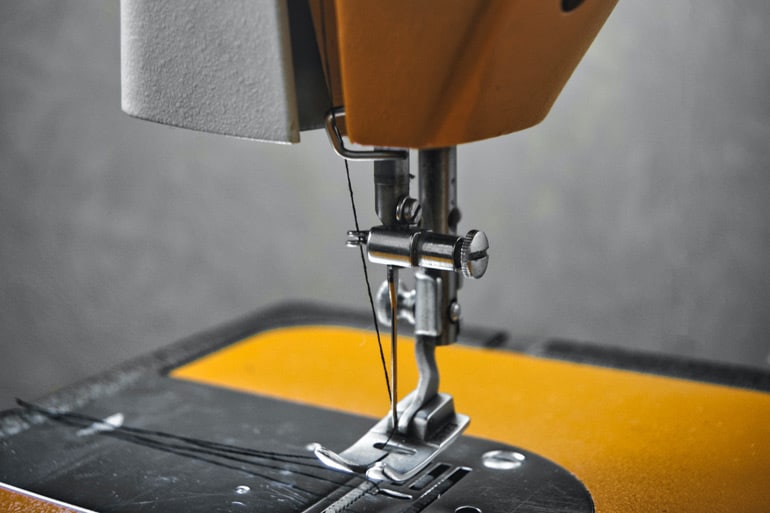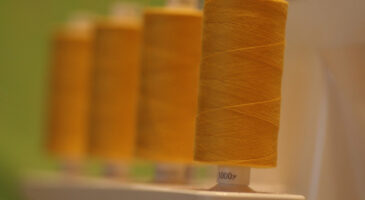Sewing machine is composed of many minor to major parts that work together to bring out what it is supposed to do. To make these parts work flawlessly and stay smooth for a long time, you need to work on maintenance and care because after all it is just a machine that can break down if not well maintained.
If you are a regular seamster or use a sewing machine very often, it is recommended to keep an eye on its working and do what needs to be done to ensure better health so they don’t end up with a sudden halt on your swing project. Cleaning and lubricating your sewing machine once in a while will bring out the best of its performance and will increase the sewing machine life too many folds.

For lubrication, a specified sewing machine oil is used which is odorless and doesn’t have color as well. You may think about what you should use to clean a sewing machine or can you use WD40 on a sewing machine. Well, we will find this out in this article.
We will also talk about the procedure and which parts should be cleaned with WD40 on a sewing machine.
Can I use WD40 for a sewing machine?
Yes, you can use WD40 on a sewing machine or we can say that using WD40 Multi-Use will bring you all the characteristics and properties that you can achieve after using multiple cleaning products.
This single product can help you clean almost all minor to major parts of your sewing machine to make it work smoothly and more efficiently. Not just for cleaning, many people use WD40 as a part time lubrication product as well.
Can I use WD40 as a lubricant on a sewing machine?
Not really, you can use WD40 as a lubricant as well but only if you don’t have sewing machine oil at the moment. Other than that, WD40 is not the best option to use as lubricant because ut has cleaning properties which even remove the previously present oil on the machine.
Using WD40 as your permanent or long term lubricating product can damage the sewing machine parts by removing the oil and allowing them to cause friction instead of making parts smooth and easy to move.
How to clean a sewing machine with WD40?
Cleaning a sewing machine is not as difficult as most people think. It may take an hour of your time but if you know the right method and sequence, cleaning the sewing machine can also become a fun activity for you. WD40 comes in a spray bottle which makes the process more easy.
- All you need is to open the parts and remove as much dirt and stuck impurities as you can using a brush.
- Spray the WD40 liquid right on the spot.
- Let the spray work for a few minutes as it will dissolve the dirt and debris on the sewing machine parts.
- Once you feel that no liquidity is on the parts, wipe off the area with a cloth and you will have a perfectly cleaned sewing machine.
How to clean sewing machine interiors with WD40?
If you work in an outside environment where many people come and go, the sewing machine interior will have a lot of dust accumulated. These impurities can cause major harm to the machine’s health if not cleaned for a long time.
- Start by opening the lid of the sewing machine.
- Take a brush and remove as much dust as you can from all minor to major parts of the machine interior. Make sure you put special attention to narrow curves and joints between different parts.
- Once most dust has been removed, spray the WD40 all over the interior even if a part is looking clean.
- Let the spray work for 5-15 minutes until you notice that the dirt is coming off the machine part and mixing with the spray.
- WD40 will dissolve all visible as well as invisible dust and impurities while bringing back the shine.
- Now take a soft and clean cloth and wipe off all the disosoavled impurities on the sewing machine interior.
- You may use a soft brush for taking out dissolved dirt from narrow curves and joints. Use a brush gently instead of going harsh and scratching different parts.
How to clean the crochet area of a sewing machine with WD40?
Crochet area is probably the most important part of a sewing machine situated right below the needle holder shaft.
The area has a lot of small curves and narrow lines that accumulate a lot of dust and debris especially because the hands and fabric keep on touching this part.
The crochet part of some sewing machines can be cleaned easily while others may need a little unscrewing as well.
- Unscrew the crochet while taking out the bobbin first. Make sure you unscrew gently without damaging the crochet itself.
- Take a brush and remove dirt and dust from all the crochet areas mainly behind and under the bobbin.
- Spray WD40 and wipe it off after it has dissolved all the impurities with itself.
- Put some oil or maybe WD40 to lubricate the area around the bobbin as it will ensure smooth movement of the tools while reducing the friction and noise.
- Wait for a few seconds after lubricating the area and then put back the bobbin and crochet with the screws.
During the whole process, make sure you don’t hit or go harsh on any parts here because any damage even if it is small can badly affect the overall performance of your sewing machine.
How to clean the foot pedal of a sewing machine with WD40?
Foot pedal is the area mostly ignored by seamstresses as it is far away from the sewing machine and does not affect its performance at all. It is true but to make things finish properly, it is always recommended to clean the foot pedal as well. Especially because the pedal is always too close to the floor and it gets dustier than any other parts.
Also, if you don’t clean it for a long time, it may not work as smoothly as it should be. Cleaning the foot pedal helps get rid of accumulated dust, debris, threads, and other impurities.
- Simply clean the area first.
- Spray WD40 on all moving parts along with the pedal itself.
- Let it work for about 10-20 minutes because dirt here will take a bit extra time to dissolve completely.
- For better results, it is recommended to keep pressing and moving the foot pedal during the waiting time so that the liquid can reach all joints and make it work smoothly afterwards.
What should I do to make my sewing machine last longer?
- Keep your sewing machine inside and cover it with cloth or something when not working.
- As soon as you hear your sewing machine making squeaky noises, put sewing machine oil on all moving parts.
- Use high-quality threads and needles because low quality threads may break very often and get stuck in different parts of the sewing machine making it quite heavy to move.
- Move a cloth all over the sewing machine after every use to stop dust snd debris bulidup.
- Alway use tools and products that are 100% suitable for your sewing projects specially, the needles, threads, and bobbins.
- Change needles overtime because they may look good but wear and tear is always happening to them.
- Interior, bobbin, needle, handwheel, and crochet area of your sewing machine should always be cleaned.
- Consider getting professional help for annual servicing of your sewing machine.
- Always seek experts help to repair sewing machine instead of doing stuff by yourself.
FAQs
Where does I shouldn’t use WD40?
Although WD40 is a great product to be used on almost all kinds of objects and tools, some items should still be avoided as WD40 can react with them while affecting their color or sometimes the product as well. Some such things include:
Polycarbonate
Clear polystyrene plastic
Door hinges
Bike chains
Paintball guns
Door locks
Mobile phones
Laptops
iPods
iPads
What was WD40 initially made for?
WD40 was originally designed to protect metal parts and tools from rust and corrosion which is bound to happen overtime. Convair was the first company to use this product on their Atlas Missiles and it worked like magic. The thing worked so efficiently that most of the WD40 bottles were missing as employees snuck cans with themselves after the lunch break.
Can I use baby oil on a sewing machine?
The single word answer is No. You should never use baby oil on sewing machines because it doesn’t have any properties or characteristics that can provide the lubrication it needs. Also some baby oil have colour and odor which can disturb you while sewing or may stain your clothes as well.



